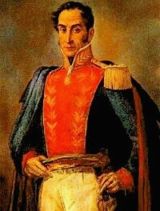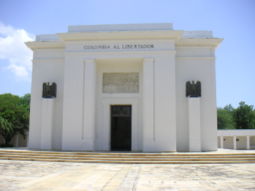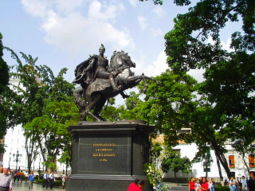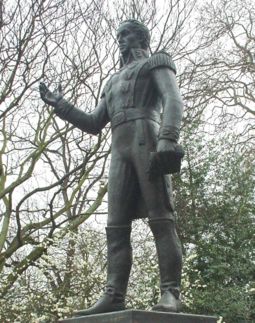Simón Bolívar
2007 Schools Wikipedia Selection. Related subjects: Historical figures
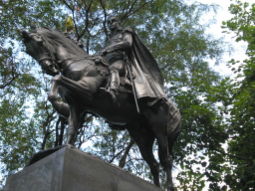
Simón José Antonio de la Santísima Trinidad Bolívar y Ponte Palacios y Blanco (born July 24, 1783 in Caracas, Venezuela; died December 17, 1830, in Santa Marta, Colombia) was a leader of several independence movements throughout South America, collectively known as Bolívar's War.
Credited with leading the fight for independence in what are now the countries of Venezuela, Colombia, Ecuador, Peru, Panama and Bolivia, he is revered as a hero in these countries and throughout much of the rest of Hispanic America.
In 1802, he married María Teresa Rodríguez del Toro y Alaysa, and when she died of yellow fever less than a year later, he never remarried.
Bolívar is known as "El Libertador", The Liberator.
Family heritage and early life
The Bolívar aristocratic bloodline derives from la Ciudad de Caracas (also Bolívar or Bolívar, today part of the municipality of Ziortza-Bolibar), a small village in the Basque county of Biscay (Spain), and is the origin of their surname. A portion of their wealth, by the 1600s, came from the Aroa River gold and copper mines in Venezuela.
By the 1500s, vague information about existence of gold was rumored around the rivers Yaracuy, Santa Cruz, and Aroa. In 1605, more precise locations of ores became known, particularly in a small valley lateral to the Aroa River next to La Quebrada de Las Minas.
In 1632, gold was first mined, leading to further discoveries of extensive copper deposits. Towards the later 1600s, copper was exploited with the name "Cobre Caracas". These mines became property of Simón Bolívar's family.
Later in his revolutionary life, Bolívar used part of the mineral income to finance the South American revolutionary wars. Some people claim that his family grew to prominence before gaining great wealth. For example, the Cathedral of Caracas, founded in 1575, has a side chapel dedicated to Simón Bolívar's family.
El Libertador (The Liberator)
Bolívar returned to Venezuela in 1807, and, when Napoleon made Joseph Bonaparte King of Spain and its colonies in 1808, he participated in the resistance juntas in South America. The Caracas junta declared its independence in 1810, and Bolívar was sent to Britain on a diplomatic mission.
Bolívar returned to Venezuela in 1811. But, in July 1812, junta leader Francisco de Miranda surrendered to the Spanish, and Bolívar had to flee to Cartagena de Indias. In this period, Bolívar wrote his Manifiesto de Cartagena.
In 1813, after acquiring a military command in New Granada under the direction of the Congress of Tunja, he led the invasion of Venezuela on May 14. This was the beginning of the famous Campaña Admirable, the Admirable Campaign. He entered Mérida on May 23, where he was proclaimed as El Libertador (the liberator from the Spanish army), following the occupation of Trujillo on June 9. Six days later, on June 15, he dictated his famous Decree of War to the Death ( Decreto de Guerra a Muerte). Caracas was retaken on August 6, 1813, and Bolívar was ratified as "El Libertador", thus proclaiming the Venezuelan Second Republic. Due to the rebellion of José Tomás Boves in 1814 and the fall of the republic, he returned to New Granada, where he then commanded a Colombian nationalist force and entered Bogotá in 1814, recapturing the city from the dissenting republican forces of Cundinamarca. He intended to march into Cartagena and enlist the aid of local forces in order to capture Royalist Santa Marta. However, after a number of political and military disputes with the government of Cartagena, Bolívar fled, in 1815, to Jamaica, where he requested the Haitian leader Alexandre Pétion for aid.
In 1816, with Haitian help (given because he promised to free slaves), Bolívar landed in Venezuela and captured Angostura (now Ciudad Bolívar).
A victory at the Battle of Boyacá in 1819 added New Granada to the territories free from Spanish control, and in September 7, 1821 the Gran Colombia (a federation covering much of modern Venezuela, Colombia, Panama, and Ecuador) was created, with Bolívar as president and Francisco de Paula Santander as vice president.
Further victories at the Carabobo in 1821 and Pichincha in 1822 consolidated his rule over Venezuela and Ecuador respectively. After a meeting in Guayaquil, on July 26 and July 27, 1822, with Argentine General José de San Martín, who had received the title of Protector of Peruvian Freedom, in August 1821, after having partially liberated Peru from the Spanish, Bolívar took over the task of fully liberating Peru. The Peruvian congress named him dictator of Peru, on February 10, 1824, which allowed Bolívar to completely reorganize the political and military administration. Bolívar, assisted by Antonio José de Sucre, decisively defeated the Spanish cavalry, on August 6, 1824, at Junín. Sucre destroyed the still numerically superior remnants of the Spanish forces at Ayacucho on December 9.
On August 6, 1825, at the Congress of Upper Peru, the Republic of Bolivia was created in order to weaken the former aristocracy of the former Viceroyalty of Peru in Lima and to honour Bolívar, who drafted a new constitution for the new nation. This constitution reflected the influence of the French and Scottish Enlightenment on Bolívar's political thought, as well as that of classical Greek and Roman authors.
Bolívar had great difficulties maintaining control of the vast Gran Colombia. During 1826, internal divisions had sparked dissent throughout the nation and regional uprisings erupted in Venezuela, thus the fragile South American coalition appeared to be on the verge of collapse.
An amnesty was declared and an arrangement was reached with the Venezuelan rebels, but political dissent in New Granada grew as a consequence of this. In an attempt to keep the federation together as a single entity, Bolívar called for a constitutional convention at Ocaña during April 1828.
He had seen his dream of eventually creating an American Revolution-style federation between all the newly independent republics, with a government ideally set-up solely to recognize and uphold individual rights, succumb to the pressures of particular interests throughout the region, which rejected that model and allegedly had little or no allegiance to liberal principles.
For this reason, and to prevent a break-up, Bolívar wanted to implement in Gran Colombia a more centralist model of government, including some or all of the elements of the Bolivian constitution he had written (which included a lifetime presidency with the ability to select a successor, though this was theoretically held in check by an intricate system of balances).
This move was considered controversial and was one of the reasons why the deliberations met with strong opposition. The convention almost ended up drafting a document which would have implemented a radically federalist form of government, which would have greatly reduced the powers of the central administration.
Unhappy with what would be the ensuing result, Bolívar's delegates left the convention. After the failure of the convention due to grave political differences, Bolívar proclaimed himself dictator on August 27, 1828 through the "Organic Decree of Dictatorship".
He considered this as a temporary measure, as a means to reestablish his authority and save the republic, though it increased dissatisfaction and anger among his political opponents. An assassination attempt on September 25, 1828 failed, in part thanks to the help of his lover, Manuela Sáenz, according to popular belief.
Although Bolívar emerged physically intact from the event, this nevertheless greatly affected him. Dissident feelings continued, and uprisings occurred in New Granada, Venezuela and Ecuador during the next two years.
Death and Legacy
Bolívar finally resigned his presidency on April 27, 1830, intending to leave the country for exile in Europe, possibly in France. He had already sent several crates (containing his belongings and his writings) ahead of him to Europe.
He died before setting sail, after a painful battle with tuberculosis on December 17, 1830, in "La Quinta de San Pedro Alejandrino", in Santa Marta, Colombia.
His remains were moved from Santa Marta to Caracas in 1842, where a monument was set up for his burial. The 'Quinta' near Santa Marta has been preserved as a museum with numerous references to his life.
Political legacy
On his deathbed, Bolívar asked his aide-de-camp, General Daniel Florencio O'Leary to burn the extensive archive of his writings, letters, and speeches. O'Leary disobeyed the order and his writings survived, providing historians with a vast wealth of information about Bolívar's liberal philosophy and thought.
A great admirer of the American Revolution (and a great critic of the French Revolution), Bolívar described himself in his many letters as a " liberal" and defender of the free market economic system. Among the books he traveled with when he wrote the Bolivian Constitution were Montesquieu's Spirit of the Laws and Adam Smith's Wealth of Nations.
Bolívar's many speeches and writings reveal him to be an adherent of limited government, the separation of powers, freedom of religion, property rights, and the rule of law.
Relatives
Simón Bolívar has no direct descendants. His bloodline lives on through his sister Juana Bolívar y Palacios who married Dionisio Palacios y Blanco (Simón and Juana's maternal uncle) and had two children: Guillermo and Benigna.
Fernando Bolívar was the nephew and adoptive son of Simon Bolívar, the great hero of South America’s wars of independence. In 1826, Fernando Bolívar preferred the University of Virginia over West Point and matriculated in 1827 against the desires of Simon Bolívar. Young Bolívar chose the University of Virginia because of his profound admiration of Thomas Jefferson’s ideas, legacy and dreams. Bolívar came to the newly opened University of Virginia to enroll in classes and began a long and still-growing link between Latin America and Jefferson’s University. Fernando Bolívar was the second international student to attend U.Va. and the first from Latin America before leaving the University to become a distinguished South American diplomat. Fernando Bolívar stayed for a brief period at U.Va, but he always treasured his days in Charlottesville and wrote about them in his memoirs.
Guillermo died when fighting alongside his uncle in the battle of La Hogaza in 1817. Benigna Palacios y Bolívar married Pedro Amestoy. Their great-grandchildren, Pedro (94) and Eduardo Mendoza Goiticoa (90) live in Caracas. They are Simón Bolívar's closest living relatives.
Honours
| Preceded by: Federation created |
President of Greater Colombia 1821–1830 |
Succeeded by: Domingo Caycedo |
| Preceded by: José Bernardo de Tagle |
Liberator of Peru February 1824 – January 1826 |
Succeeded by: Andres de Santa Cruz |
| Preceded by: Republic created |
President of Bolivia 1825–1826 |
Succeeded by: Antonio José de Sucre |
In addition to the statues shown elsewhere in this article, there is an equestrian statue commemorating Bolívar's life and works in Washington, D.C a statue in Cairo, Egypt, a statue on Reforma Ave. in Mexico City, and another Statue signifying Friendship between Quebec and South America in Quebec City.
